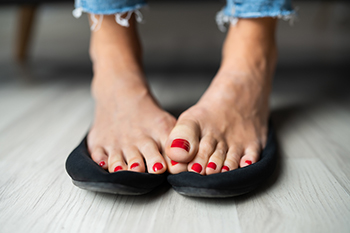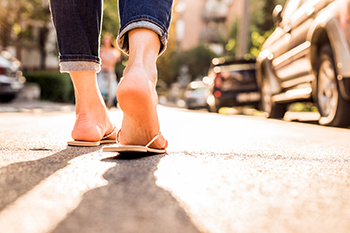Items filtered by date: January 2023
Dealing With Athlete’s Foot

Tinea is a fungus that feeds on skin, hair, and nails. Many people are familiar with athlete’s foot, also called tinea pedis. This fungal infection grows in the moist skin between the toes. Symptoms include redness, itching, and scaly or oozing skin. Athlete’s foot is highly contagious, often contracted by walking barefoot on wet floors in public showers, gym locker rooms, or swimming pool areas. In some cases, it can spread to the toenails, termed tinea unguium. This results in nails that are thick and crumbling. Be careful not to touch the infected areas of your feet, because the fungus can be easily spread to the hands, face, and other body parts. Athlete’s foot can be treated with a variety of lotions, creams, and medications. Prevention, however, is the best cure. Wear protective foot coverings in places where tinea thrives, and avoid sharing towels, foot coverings, or socks with others. Dry your feet thoroughly, especially between the toes, and wear different pairs of socks each day. For relief from a stubborn case of athletes’ foot, please see a podiatrist who can prescribe stronger antifungal medications.
Athlete’s Foot
Athlete’s foot is often an uncomfortable condition to experience. Thankfully, podiatrists specialize in treating athlete’s foot and offer the best treatment options. If you have any questions about athlete’s foot, consult with Darren Day, DPM from Hawaii. Our doctor will assess your condition and provide you with quality treatment.
What Is Athlete’s Foot?
Tinea pedis, more commonly known as athlete’s foot, is a non-serious and common fungal infection of the foot. Athlete’s foot is contagious and can be contracted by touching someone who has it or infected surfaces. The most common places contaminated by it are public showers, locker rooms, and swimming pools. Once contracted, it grows on feet that are left inside moist, dark, and warm shoes and socks.
Prevention
The most effective ways to prevent athlete’s foot include:
- Thoroughly washing and drying feet
- Avoid going barefoot in locker rooms and public showers
- Using shower shoes in public showers
- Wearing socks that allow the feet to breathe
- Changing socks and shoes frequently if you sweat a lot
Symptoms
Athlete’s foot initially occurs as a rash between the toes. However, if left undiagnosed, it can spread to the sides and bottom of the feet, toenails, and if touched by hand, the hands themselves. Symptoms include:
- Redness
- Burning
- Itching
- Scaly and peeling skin
Diagnosis and Treatment
Diagnosis is quick and easy. Skin samples will be taken and either viewed under a microscope or sent to a lab for testing. Sometimes, a podiatrist can diagnose it based on simply looking at it. Once confirmed, treatment options include oral and topical antifungal medications.
If you have any questions, please feel free to contact our offices located in Honolulu and Kahuku, HI . We offer the newest diagnostic and treatment technologies for all your foot care needs.
Sweaty Feet Can Be Helped

There is a small percentage of people worldwide who have excessively sweaty feet. This is a condition that is known as plantar hyperhidrosis, which can cause embarrassment. Many people find their shoes have become ruined and have to replace them more often. Falling may happen as a result of slipping from any excess moisture on the feet, and foot odor may become increased. Relief may be found when powder is put inside the shoe, in addition to wearing specific shoe inserts. This may help feet to refrain from moving in the shoe. It is beneficial to wear shoes and socks that are made of breathable materials, which may help to absorb the excess moisture. If you suffer from this uncomfortable foot condition, please schedule a visit with a podiatrist who can guide you toward proper treatment techniques.
If you are suffering from hyperhidrosis contact Darren Day, DPM of Hawaii. Our doctor can provide the care you need to attend to all of your foot and ankle needs.
Hyperhidrosis of the Feet
Hyperhidrosis is a rare disorder that can cause people to have excessive sweating of their feet. This can usually occur all on its own without rigorous activity involved. People who suffer from hyperhidrosis may also experience sweaty palms.
Although it is said that sweating is a healthy process meant to cool down the body temperature and to maintain a proper internal temperature, hyperhidrosis may prove to be a huge hindrance on a person’s everyday life.
Plantar hyperhidrosis is considered to be the main form of hyperhidrosis. Secondary hyperhidrosis can refer to sweating that occurs in areas other than the feet or hands and armpits. Often this may be a sign of it being related to another medical condition such as menopause, hyperthyroidism and even Parkinson’s disease.
In order to alleviate this condition, it is important to see your doctor so that they may prescribe the necessary medications so that you can begin to live a normal life again. If this is left untreated, it is said that it will persist throughout an individual’s life.
A last resort approach would be surgery, but it is best to speak with your doctor to find out what may be the best treatment for you.
If you have any questions please feel free to contact our offices located in Honolulu and Kahuku, HI . We offer the newest diagnostic and treatment technologies for all your foot and ankle needs.
Facts About Achilles Tendonitis

Achilles tendonitis is a condition that affects the large tendon that connects the calf muscles to the heel. When the Achilles tendon becomes inflamed, most commonly from overuse, it causes pain in the back of the foot and the heel. Most at risk for this type of injury are active adults between 30 and 50 years old. The pain often worsens after exercising and can be accompanied by stiffness, swelling, and tenderness to the touch. Because Achilles tendonitis is an overuse injury, it is a good idea to avoid sudden increases in the amount or frequency of exercise. Jumping repeatedly during exercise and running on hard surfaces also can add to the damage. Most importantly, choose supportive footwear that provides ample cushioning and arch support. If you believe you may have an Achilles tendon injury, please consult a podiatrist who can perform diagnostic tests to determine the severity of the condition and offer appropriate treatment options.
Achilles tendon injuries need immediate attention to avoid future complications. If you have any concerns, contact Darren Day, DPM of Hawaii. Our doctor can provide the care you need to keep you pain-free and on your feet.
What Is the Achilles Tendon?
The Achilles tendon is a tendon that connects the lower leg muscles and calf to the heel of the foot. It is the strongest tendon in the human body and is essential for making movement possible. Because this tendon is such an integral part of the body, any injuries to it can create immense difficulties and should immediately be presented to a doctor.
What Are the Symptoms of an Achilles Tendon Injury?
There are various types of injuries that can affect the Achilles tendon. The two most common injuries are Achilles tendinitis and ruptures of the tendon.
Achilles Tendinitis Symptoms
- Inflammation
- Dull to severe pain
- Increased blood flow to the tendon
- Thickening of the tendon
Rupture Symptoms
- Extreme pain and swelling in the foot
- Total immobility
Treatment and Prevention
Achilles tendon injuries are diagnosed by a thorough physical evaluation, which can include an MRI. Treatment involves rest, physical therapy, and in some cases, surgery. However, various preventative measures can be taken to avoid these injuries, such as:
- Thorough stretching of the tendon before and after exercise
- Strengthening exercises like calf raises, squats, leg curls, leg extensions, leg raises, lunges, and leg presses
If you have any questions please feel free to contact our offices located in Honolulu and Kahuku, HI . We offer the newest diagnostic tools and technology to treat your foot and ankle needs.
It's Time for Beautiful Feet
How Obesity Affects the Feet

Extra weight can have a detrimental effect on your feet. Beyond achy and tired feet, problems from obesity can lead to arthritis in the feet. Overweight individuals might notice that their ankles become weaker as their weight increases, and this can lead to increased injuries. With obesity, there is also an increased chance of becoming diabetic, a condition that comes with a host of foot issues. Wearing supportive footwear is important to decrease the amount of strain put on the feet. Losing weight should be the focus of lessening how obesity affects the feet. Changing one’s diet is the most obvious way to help lose weight. Eating healthy foods and those that decrease inflammation is recommended. Diabetics need to make sure that they manage their blood sugar well. Even mild exercise will help in controlling weight. If you are obese and it is affecting your feet, seeing a podiatrist is suggested. This medical professional can help keep your feet as comfortable as possible while weight loss is undertaken.
The more you weigh, the harder your feet must work to support your body. If you’re an obese individual and are concerned about your feet, contact Darren Day, DPM from Hawaii. Our doctor can provide the care you need to keep you pain-free and on your feet.
Obesity and Your Feet
People who are overweight are putting more pressure on their ankles, knees, and hips as well as their feet. This unfortunately can lead to variety of different issues.
Problems & Complications Stemming from Obesity
- When the body is overweight, it tries to compensate by changing the way that it moves. An obese person may lean forward and put extra weight on the wrong part of the foot. This puts unnecessary stress on the feet.
- Obese people are also more likely to develop type II diabetes which is a condition that causes a lot of foot problems. People with diabetes often don’t feel the cuts and sores that they may have on their feet, which can lead to more complicated and severe issues.
- Plantar fasciitis is another foot condition that can be caused by obesity. Plantar fasciitis is an inflammation of the tissue along the bottom of the foot, which causes pain and stiffness while walking and climbing stairs.
If you have any questions, please feel free to contact our offices located in Honolulu and Kahuku, HI . We offer the newest diagnostic and treatment technologies for all your foot care needs.
Why Flip Flops Are Popular

Flip flops are a popular shoe to wear during the warmer months. Despite the foot problems they may cause, many people choose to wear this type of shoe for their simplicity and varied colors. People who frequently wear them may experience heel pain as a result of the decreased cushioning these shoes generally have. The toes may begin to ache from gripping the shoes to keep them on the feet. At the end of the day, the feet may feel tired, which can radiate to the overall body. Additionally, blisters may form from the small piece of rubber that exerts pressure between the big toe and the second toe. Some flip-flops are made with stronger materials and may provide adequate support and cushioning to the feet. There are various styles of flip-flops, and if you are interested in learning more about them, please confer with a podiatrist who can answer any questions you may have.
Flip-flops are not always the best choice of footwear. If you have any concerns about your feet or ankles, contact Darren Day, DPM from Hawaii. Our doctor will assist you with all of your foot and ankle needs.
Flip-Flops and Feet
When the weather starts warming up, people enjoy wearing flip-flops. Flip-flops are comfortable, stylish, and easy to slip on and off; they're perfect for any summer beach goer. However, these shoes can cause harm to the feet.
How Can Flip-Flops Affect Me Long-Term?
- Ankle problems
- Hip problems
- Lower back problems
- Pain in the balls of the feet
- Problems with foot arches
- Changes in the way you walk
Are There Injuries Associated with Flip-Flops?
Yes. Since flip-flops are relatively weak and do not provide the same amount of support as sneakers, people who wear flip-flops regularly are more susceptible to injuries. On top of that, the open nature of the shoe makes your feet more prone to other problems, such as cuts and even infections. Common injuries and ailments include:
- Sprained ankles
- Blisters
- Infections
- Cuts and Scrapes
I like Wearing Flip-Flops. Are There Safe Alternatives?
When buying flip-flops, try to find ones that have sturdy soles and that are made of high-quality materials that will support for your feet. These flip-flops will cost more but will also last longer as a result.
If you have any questions please feel free to contact our offices located in Honolulu and Kahuku, HI . We offer the newest diagnostic and treatment technologies for all your foot and ankle needs.






